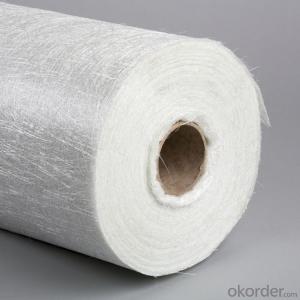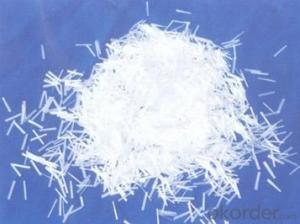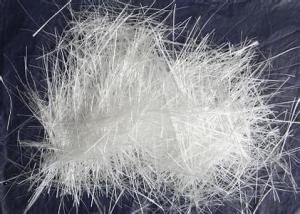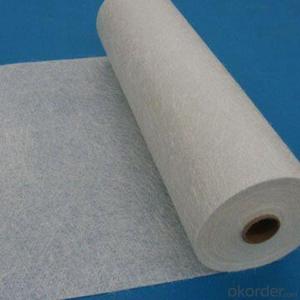100g/m2 Fiberglass Chopped Strand Mat
- Loading Port:
- China main port
- Payment Terms:
- TT OR LC
- Min Order Qty:
- 1 kg
- Supply Capability:
- 5000 kg/month
OKorder Service Pledge
OKorder Financial Service
You Might Also Like
Product Description:
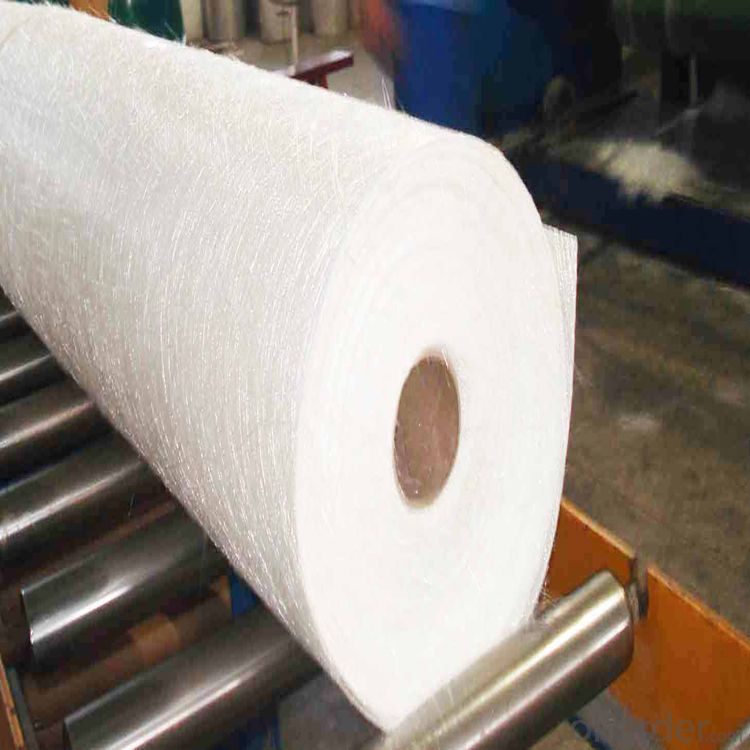
Surfacing Tissue mainly used in the surface layers of FRP products. It features even Fiber distribution, soft feel, level and smooth fiber surface, less glue content, quick resin soak and good pattern fitness. It can improve the product surface property on corrosion resistance, compressive strength, seepage resistance, and longer service life. It is also suitable for spraying; pattern pressing and other FRP pattern technology.
Surfacing Tissue mainly used in the surface layers of FRP products. It features even Fiber distribution, soft feel, level and smooth fiber surface, less glue content, quick resin soak and good pattern fitness. It can improve the product surface property on corrosion resistance, compressive strength, seepage resistance, and longer service life. It is also suitable for spraying; pattern pressing and other FRP pattern technology.
Product Features:
Fast breakdown in styrene
Fiber dispersed evenly
Low binder content
Superior acid corrosion resistance
Specifications:
Item | Over Density | Moisture Content | Chop Density | Polyester Yarn | Width |
(g/m2) | (%) | (g/m2) | (g/m2) | (mm) | |
EMK300 | 309.5 | ≤0.15 | 300 | 9.5 | 50-3300 |
EMK380 | 399 | 380 | 19 | ||
EMK450 | 459.5 | 450 | 9.5 | ||
EMK450 | 469 | 450 | 19 | ||
EMC0020 | 620.9 | 601.9 | 19 | ||
EMC0030 | 909.5 | 900 | 9.5 |
Product Packaging:
Each Surface Tissue is wound onto a paper tube which has an inside diameter of 76mm and the mat roll has a diameter of 330mm. The mat roll is wrapped up with plastic film,and then packed in a cardboard box or wrapped up with kraft paper. The rolls can be vertically or horizontally placed. For transportation, the rolls can be loaded into a cantainer directly or on pallets.
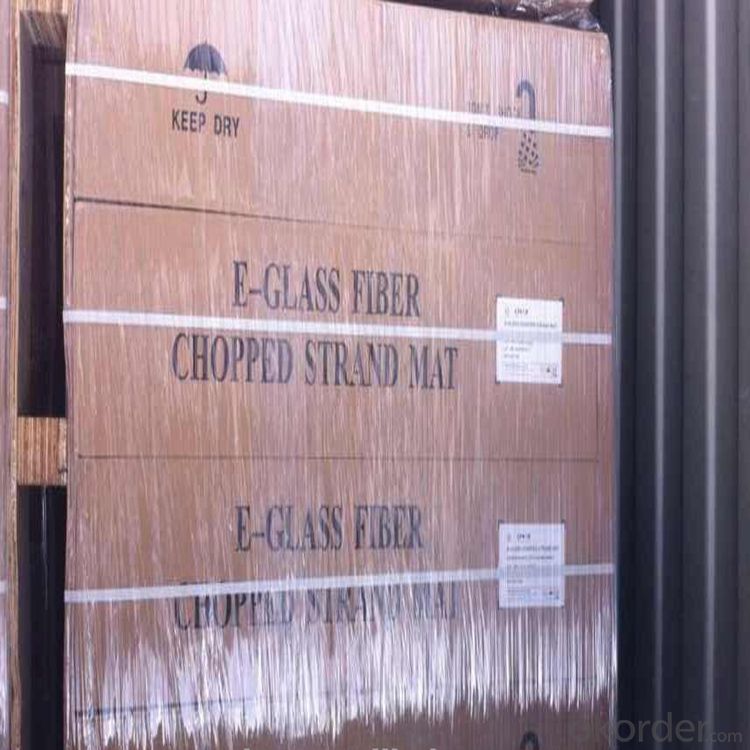
Product Storage:
Unless otherwise specified, Chopped Strand Mat should be stored in a dry, cool and rain-proof area. It is recommended that the room temperature and humidity should be always maintained at 15℃~35℃ and 50%~75% respectively.
Company Information
CNBM (China National Building Material) Group is the largest comprehensive building materials group in China that in integrate scientific research, manufacturing and logistics into one entity. The largest building materials and equipment specialists in China. Upon State Council approval, today CNBM owned more than 300 subordinate manufacturing factories and servicing companies. There are 6 fully owned public listed companies and 11 partially owned with substantial shares public listed companies. In many of these fields, CNBM is playing the leading role in the building industry in the country.

- Q:What are the typical processing challenges when using fiberglass chopped strand composites?
- When using fiberglass chopped strand composites, there are several typical processing challenges that may arise. One of the main challenges is achieving consistent fiber dispersion throughout the composite material. Since chopped strand composites consist of short lengths of fiber, it can be difficult to ensure that the fibers are evenly distributed within the resin matrix. This can lead to areas of low fiber content, resulting in reduced mechanical properties and potential weaknesses in the final product. Another challenge is managing the processing temperature. Fiberglass chopped strand composites typically require higher processing temperatures compared to other materials. This can pose challenges in terms of selecting the appropriate processing equipment and ensuring that the temperature remains within the optimal range throughout the manufacturing process. Failure to control the temperature can result in poor resin flow, incomplete curing, or even degradation of the fibers. Furthermore, the abrasive nature of fiberglass can lead to increased wear and tear on processing equipment. The sharp edges of the chopped fibers can cause excessive wear on molds, dies, and other components of the production machinery. This requires regular maintenance and replacement of parts, adding to the overall cost and complexity of the manufacturing process. Additionally, the handling and storage of chopped strand composites can be challenging. The fibers are prone to breakage and entanglement, which can make it difficult to handle and feed them into the processing equipment. Proper storage conditions, such as maintaining low humidity levels, are also crucial to avoid moisture absorption by the fibers, which can negatively affect their performance and adhesion to the resin matrix. Lastly, achieving consistent and reliable bonding between the fibers and the resin matrix can be a challenge. The short lengths of the chopped fibers make it more difficult to achieve a strong bond, which can result in reduced mechanical strength and potential delamination issues in the final product. Special attention needs to be given to the resin formulation and processing parameters to ensure optimal fiber-matrix adhesion. Overall, while fiberglass chopped strand composites offer numerous advantages such as high strength-to-weight ratio and corrosion resistance, they also present several processing challenges that need to be carefully addressed to achieve high-quality and reliable end products.
- Q:What are the dimensional stability properties of fiberglass chopped strand?
- The dimensional stability properties of fiberglass chopped strand refer to its ability to retain its shape and size under various conditions. Fiberglass chopped strand is known for its excellent dimensional stability, meaning it is resistant to shrinking, warping, or expanding when subjected to changes in temperature, humidity, or mechanical stress. This makes it a reliable material for applications where maintaining precise dimensions is crucial.
- Q:How does the fiber diameter affect the properties of fiberglass chopped strand?
- The fiber diameter of fiberglass chopped strand has a significant impact on its properties. The diameter of the fibers directly affects the strength, flexibility, and overall performance of the fiberglass. A smaller fiber diameter generally results in increased strength and stiffness of the chopped strand. This is because the smaller fibers can pack closely together, increasing the overall fiber volume fraction, and thus enhancing the load-bearing capacity of the material. Additionally, smaller fibers tend to have fewer defects or imperfections, which further enhances their strength. On the other hand, larger fiber diameters may contribute to increased flexibility and impact resistance of the chopped strand. The larger fibers provide more room for movement and deformation, allowing the material to absorb and dissipate energy during impact or bending. This can be advantageous in applications where toughness and resilience are essential, such as in automotive parts or sports equipment. The fiber diameter also influences the surface area of the chopped strand. Smaller fibers have a larger surface area per unit volume, which can enhance the bonding and adhesion of the fibers with the resin matrix. This leads to improved mechanical properties, such as increased tensile strength and better resistance to delamination. Furthermore, the fiber diameter affects the processing characteristics of the chopped strand. Smaller fibers tend to disperse more easily in the resin, resulting in a more homogeneous mixture and better overall performance. On the other hand, larger fibers may require additional processing steps, such as chopping or grinding, to achieve proper dispersion and ensure uniformity in the final product. In summary, the fiber diameter of fiberglass chopped strand plays a crucial role in determining its mechanical, processing, and performance properties. The selection of the appropriate fiber diameter depends on the specific application requirements, balancing factors such as strength, flexibility, impact resistance, and processability.
- Q:Can fiberglass chopped strand be used in electrical transformers?
- Yes, fiberglass chopped strand can be used in electrical transformers. It is commonly used as a reinforcing material in the production of transformer cores and insulation components due to its excellent electrical insulation properties and thermal stability.
- Q:What are the typical impact resistance properties of chopped strand composites?
- The typical impact resistance properties of chopped strand composites depend on several factors such as the type and length of the fibers used, the resin matrix, and the manufacturing process. However, in general, chopped strand composites exhibit good impact resistance due to the random orientation of the fibers which helps distribute and absorb the impact energy. Additionally, the high strength-to-weight ratio of these composites further enhances their impact resistance.
- Q:What are the typical hardness properties of fiberglass chopped strand composites?
- The hardness properties of fiberglass chopped strand composites can vary depending on their specific composition and manufacturing process. However, fiberglass composites are generally known for their excellent hardness properties. Fiberglass chopped strand composites typically have a high level of hardness due to the reinforcing glass fibers. These fibers are typically embedded in a matrix material, such as resin, which adds strength and stability to the composite. The hardness of fiberglass chopped strand composites is often measured using the Rockwell hardness scale or the Vickers hardness test. These tests assess how resistant the material is to indentation or penetration by a harder material. Several factors influence the hardness properties of fiberglass chopped strand composites, including the length and orientation of the glass fibers, the type of resin used, and the overall ratio of fibers to resin. Generally, longer and more aligned fibers contribute to increased hardness. Fiberglass composites are widely used in industries like automotive, aerospace, construction, and marine due to their exceptional hardness properties. They offer excellent resistance to abrasion, impact, and deformation, making them suitable for applications that require durability and strength. It's worth noting that the specific hardness properties of fiberglass chopped strand composites can vary depending on the application requirements and manufacturing process. Therefore, it's advisable to consult the manufacturer or conduct specific tests to determine the exact hardness properties of a particular fiberglass chopped strand composite.
- Q:How is the fire resistance of fiberglass chopped strand determined?
- Determining the fire resistance of fiberglass chopped strand involves a series of standardized tests and evaluations. The most commonly employed method is the ASTM E84 test, also referred to as the Steiner Tunnel test. This test gauges the surface burning characteristics of materials by examining their flame spread and smoke development. During the test, a controlled flame is applied to a sample of fiberglass chopped strand, and the rate of flame spread is measured. Additionally, the test evaluates the amount of smoke generated during the burning process. Based on the findings, the material is assigned a Class rating, which ranges from Class A (denoting the highest fire resistance) to Class C (denoting the lowest fire resistance). Apart from the ASTM E84 test, other tests like the UL 94 test can be employed to determine the fire resistance of fiberglass chopped strand. This test assesses the material's capacity to self-extinguish following exposure to a small flame. The results of this test yield a V rating, with V-0 indicating the highest fire resistance and V-2 indicating the lowest fire resistance. These standardized tests offer a reliable and consistent means of assessing the fire resistance of fiberglass chopped strand, thereby ensuring its compliance with the necessary safety standards for diverse applications.
- Q:Uses of alkali free glass fiber.
- According to the orders of reinforced material combination,the fabric surface is sill-like: Along the width of the direction of the area, the quality is uniform,twistless roving is chopped and sprayed in the net with the certain shape and distributed in the resin paste; the smooth surface make the surface of the glass steel smooth. Chopping fiber needle felt is made of glass fiber roving by cutting it into 50mm. Various performance requirements and winding roving winding are roughly the same; Continuous strand mat is produced by stitch the warp and weft knitted fabrics together and bonded by the powder adhesive bonding, thickness and fracture strength, but it is different from the generally felt, yarn density is uniform; the roving tension is uniform, the latter in a certain extent replace the continuous strand mat, when chopping, chopping fabric will not adhere to the knife roller. Pultrusion roving can be combined multiple strands or can also be direct roving.
- Q:How does the fiber length affect the flow behavior of chopped strand composites?
- The fiber length in chopped strand composites directly affects the flow behavior of the material. Longer fibers tend to align better during processing, leading to improved flow and reduced void formation. Shorter fibers, on the other hand, may result in poorer flow behavior and increased likelihood of agglomeration or uneven distribution throughout the composite.
- Q:How does the dimensional stability of the chopped strand affect its performance?
- The dimensional stability of the chopped strand directly affects its performance. When a chopped strand has good dimensional stability, it maintains its shape and size even under different environmental conditions, such as temperature and humidity changes. This stability ensures consistent performance and allows the chopped strand to effectively reinforce the material it is being used in. On the other hand, poor dimensional stability can lead to changes in the chopped strand's shape and size, resulting in reduced performance and potential failure in the material it is reinforcing.
1. Manufacturer Overview |
|
|---|---|
| Location | |
| Year Established | |
| Annual Output Value | |
| Main Markets | |
| Company Certifications | |
2. Manufacturer Certificates |
|
|---|---|
| a) Certification Name | |
| Range | |
| Reference | |
| Validity Period | |
3. Manufacturer Capability |
|
|---|---|
| a)Trade Capacity | |
| Nearest Port | |
| Export Percentage | |
| No.of Employees in Trade Department | |
| Language Spoken: | |
| b)Factory Information | |
| Factory Size: | |
| No. of Production Lines | |
| Contract Manufacturing | |
| Product Price Range | |
Send your message to us
100g/m2 Fiberglass Chopped Strand Mat
- Loading Port:
- China main port
- Payment Terms:
- TT OR LC
- Min Order Qty:
- 1 kg
- Supply Capability:
- 5000 kg/month
OKorder Service Pledge
OKorder Financial Service
Similar products
New products
Hot products
Related keywords
